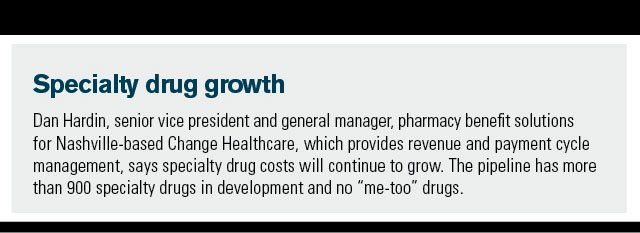How RA, Cancer, Hep C Drug Costs Will Change Over Next Five Years
Experts weigh in on the spending outlook for these high-cost conditions.

Inflammatory conditions took the lead in drug spending in 2017-a 15.3% increase over 2016-with $157.49 per person per year. Spending is expected to climb another 16% in 2018, 15% in 2019, and 14% in 2020, according to the Express Scripts 2017 Drug Trend Report.
Oncology ranked third after diabetes in spending with a 17.4% increase over 2016-$70.66 per person per year-with projected increases of 17%, 13%, and 11.3% for 2018, 2019 and 2020, respectively, the report says.
By 2022, the top 15 cancer drugs are predicted to accrue almost $90 billion in sales, about one-fourth of the U.S., pharmaceutical market in 2014, according to QuintilesIMS.
Hepatitis C indicates a decline in spend from 2017 to 2020, ranking 14th in Express Scripts’ top therapy classes with a decrease of -31.2% in 2017 compared to 2016, and additional projected decreases of -11.1%, -0.1% and -1.6%, from 2018 to 2020, respectively.
While inflammatory conditions and oncology have remained first and third on the spend list for 2015 and 2016, respectively, hepatitis C fell from fourth in 2015 to 11th in 2016.
Spending in all three therapeutic categories is plagued by high-cost specialty drugs, leaving managers of pharmacy benefits struggling to find savings.
RA
Ken Majkowski, PharmD, chief pharmacy officer at FamilyWize, a community-based organization that offers a free prescriptions savings program, believes RA drug costs might decrease with the introduction of biosimilars for Humira (adalimumab) and Remicade (infliximab).
Humira’s dominance in the RA marketplace is to blame for high costs, says Christine Strahl, PharmD, senior manager of specialty pharmacy programs for HealthPartners, a health plan. “Discounts have not kept pace with Humira’s rising cost even though there is competition. With the largest list of indications, it remains in the driver’s seat.”
Glen Stettin, MD, senior vice president and chief innovation officer for Express Scripts, agrees with his PBM’s trend report: Utilization of RA drugs will increase. However, he is more optimistic about the opportunity to leverage existing competition by indication through formulary preferences, keeping RA drug prices in tow.
Next: Cancer
Cancer
Jessica Turgon, principal at ECG, a management consulting firm, predicts that prices for cancer drugs will rise in the next five years as the FDA approves more drugs for oncology conditions. “Manufacturers are trying to recoup their investment in developing high-cost drugs, but they are feeling pressure from the industry to keep increases at 10% or lower,” she says. “There are no price controls.”
Strahl agrees. “There are only about two to three drugs per cancer indication so there’s not much activity by manufacturers to discount them,” she says. “It’s up to PBMs and insurers to pressure them; manufacturers are primarily in the driver’s seat.”
Stettin expects a robust oncology pipeline but going forward, he also predicts less competition due to specification. On the other hand, he anticipates that generic versions of Gleevec could impact drug pricing.
Mona Chitre, PharmD, chief pharmacy officer and vice president, clinical operations and health innovation, Excellus BlueCross BlueShield, attributes the rising cost of oncology drugs to new combinations, such as Opdivo (nivolumab) that has been used as a single agent to treat metastatic melanoma and is now prescribed in combination with Yervoy (ipilimumab). The price has jumped from a $150,000 single agent to $250,000 for both.
David Lassen, PharmD, chief clinical officer, Prime Therapeutics, a PBM, attributes the higher cost of drugs to their marked improvement in efficacy, advancement toward a cure, lack of competition, and new drugs targeting additional indications.
Hep C
Stettin says Hep C drug utilization has tanked and will be flat by 2019 to 2020 even though drugs for the condition are expensive. “Hepatitis C is extremely well managed, and we have identified those who need the drugs and ensured adherence,” he says.
Strahl, of HealthPartners also expects utilization to decrease but right now she says there is a slight increase with new drugs that fight resistance experienced by some patients on other drugs. Among them are Mavyret (glecaprevir/pibrentasvir).
HealthPartners has created a Pharmacy Navigator program for Hep C that supports members on high-cost drugs through personalized outreach to increase adherence and contain costs.
Mari Edlin, a frequent contributor to Managed Healthcare Executive, is based in Sonoma, California.
This week on Tuning Into The C-Suite Briana Contreras spoke with Dr. Scott Hayworth, president and CEO of New York-based CareMount Medical. In this interview, the two discussed the importance of patients staying in contact with their doctors for the sake of reducing public health risks and to discuss ongoing care options with them.
Listen
Eric Levin talks PBMs and how Scripta is Tackling the Market's Challenges for Patients
July 22nd 2020MHE's Briana Contreras spoke with CEO of Scripta, Eric Levin. The two discussed the current state of the pharmacy benefit market and how the Scripta organization has been assisting its clients and their prescriptions prior to the COVID-19 pandemic and during.
Listen